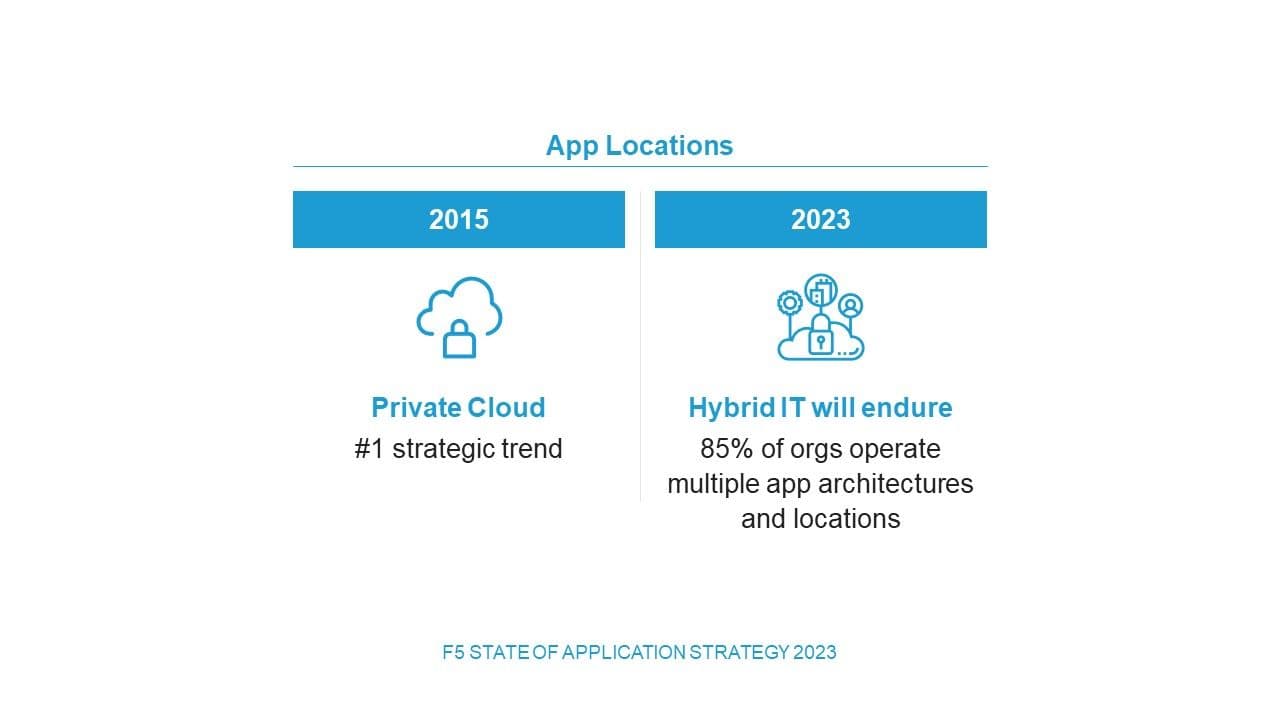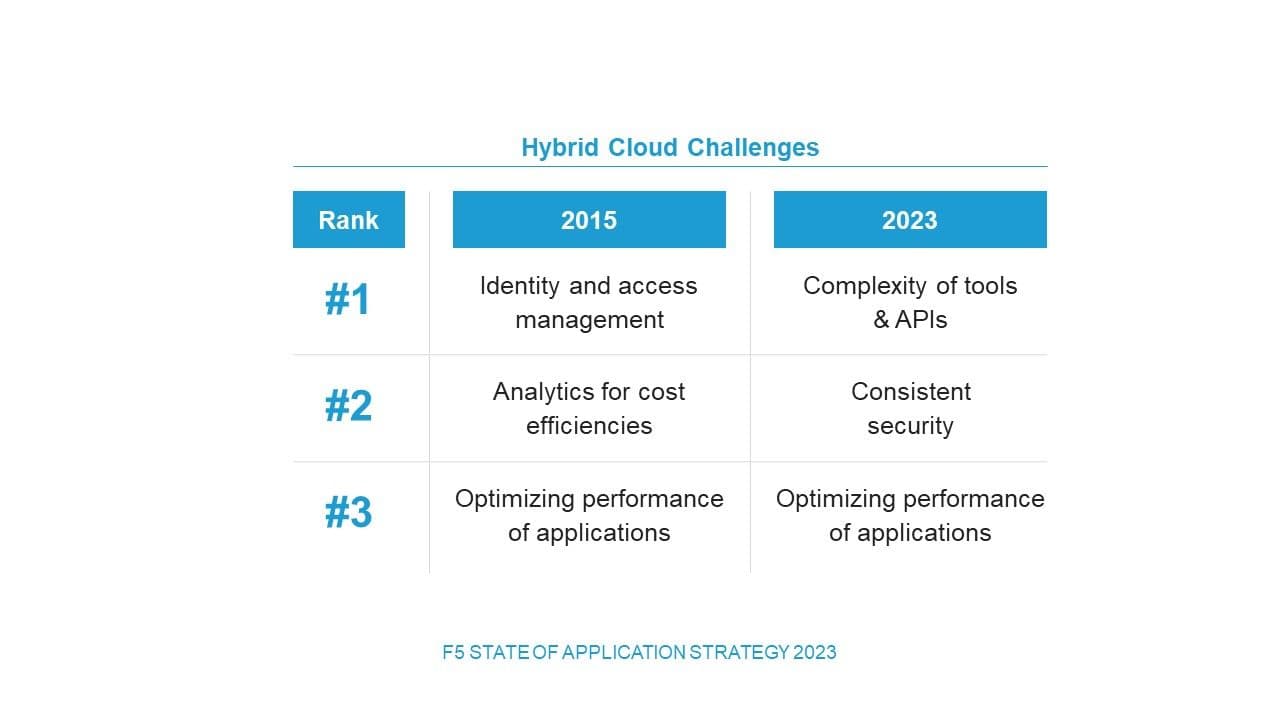In 2014 Lori MacVittie and I started discussing how application services were integral to the apps that were going to power digital transformation initiatives. We posited that the success of these business initiatives would ultimately rest on the performance, delivery, and security of the applications. The promise of digital transformation was just beginning to change the way we work and play, Pharrell Williams’ “Happy” was Billboard’s #1 song of 2014, and Disney’s “Frozen” dominated the holiday toy list with all things Elsa and Olaf. Let’s look back at our initial findings to see where we were and the learnings we found along the way.
Private cloud was the number one trend in our first report in 2015. The CapEx benefits of server virtualization were real with 80% of x86 workloads virtualized, but organizations were looking to gain the agility and flexibility that comes with a truly software-driven approach across the entire IT stack. Hesitant to give up data sovereignty to the public cloud, most organizations choose to get their own data centers in order.
We have come a long way from the public vs. private debates of yesteryear. In our 2023 report we found that the average IT stack will remain hybrid, with capabilities such as compute, network, storage, and applications distributed widely across core, cloud, and edge environments. It’s not only clouds that can be considered “hybrid.” Organizations will continue to manage multiple, disparate technology stacks and support different generations of infrastructure and apps. In 2024 we are expecting hybrid to remain with lessons learned from the early days of cloud applied to AI. Organizations will take a thoughtful approach to where they locate and distribute their AI models/workloads, choosing to prioritize data sovereignty AND leveraging industry-leading publicly available large language models.

Hybrid Challenges
In our first report organizations were grappling with hybrid challenges, specifically how to provide identity and access management across hybrid cloud deployments. Determining the best approach to single sign-on was dominating the tech agenda with the first step inventorying the application locations and architectures. Fortunately, the industry responded to remove identity and access barriers, making identity and access the most widely deployed app services today. Sadly, new challenges have emerged, and others endured.
The myriad of tools and APIs, each with slightly different features and functionality from different tech and cloud service providers, is placing a massive burden on already time-squeezed IT teams, with a resulting lack of standardization and integration. Consistent security across hybrid locations and app architectures has been a top challenge since 2018 where it steadfastly remains today. Organizations are looking to consistently deploy security across their hybrid estate that meets the many regulatory requirements in which global organizations operate. These top two hybrid challenges support why multi-cloud networking (MCN), which abstracts the connectivity between multiple cloud locations and architectures, was a top trend in 2023.
And performance of applications—well, it was a top trend in our first report and will not go away any time soon. According to Google, as page load times increase from 1 second to 10 the probability of a mobile site visitor bouncing increases 123%. Public-facing apps are not the only focus of performance. Our State of Application Strategy research finds digital transformation efforts are just as likely to focus on internal business functions where employee productivity and satisfaction are key outcomes made possible by high-performance applications.

Predictions for 2024? Surprise, surprise: Generative AI will be a top trend, and I predict organizations will be more thoughtful where they place their AI models, taking both a realistic view of staffing skill sets and costs while assessing the long-term strategic benefits. As for songs, I’m placing a safe bet on one from Taylor Swift along with her friendship bracelets topping the list of gifts. Top of my list for friendship bracelets will be Lori MacVittie, and we are hoping you will give us the gift of taking the just-opened SOAS survey for 2024 to put a dose of reality into all this AI excitement. Stay to the end of the survey to let us know which trends you regretted from 2014, because we have a lot to learn in looking back at our misses as well. For instance, I thought SDN would usher in a new age of agility powered by automation for NetOps and SecOps professionals. I’m still hopeful but now I’m much more realistic about the pace of operational change.
About the Author

Related Blog Posts

AppViewX + F5: Automating and orchestrating app delivery
As an F5 ADSP Select partner, AppViewX works with F5 to deliver a centralized orchestration solution to manage app services across distributed environments.

Build a quantum-safe backbone for AI with F5 and NetApp
By deploying F5 and NetApp solutions, enterprises can meet the demands of AI workloads, while preparing for a quantum future.

F5 ADSP Partner Program streamlines adoption of F5 platform
The new F5 ADSP Partner Program creates a dynamic ecosystem that drives growth and success for our partners and customers.
F5 NGINX Gateway Fabric is a certified solution for Red Hat OpenShift
F5 collaborates with Red Hat to deliver a solution that combines the high-performance app delivery of F5 NGINX with Red Hat OpenShift’s enterprise Kubernetes capabilities.
F5 Silverline Mitigates Record-Breaking DDoS Attacks
Malicious attacks are increasing in scale and complexity, threatening to overwhelm and breach the internal resources of businesses globally. Often, these attacks combine high-volume traffic with stealthy, low-and-slow, application-targeted attack techniques, powered by either automated botnets or human-driven tools.
Phishing Attacks Soar 220% During COVID-19 Peak as Cybercriminal Opportunism Intensifies
David Warburton, author of the F5 Labs 2020 Phishing and Fraud Report, describes how fraudsters are adapting to the pandemic and maps out the trends ahead in this video, with summary comments.
